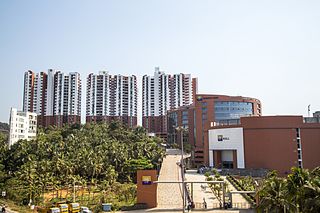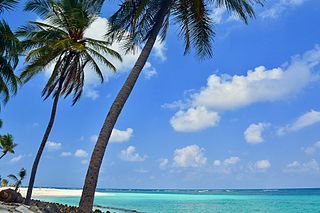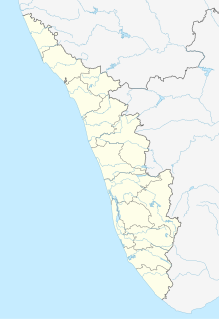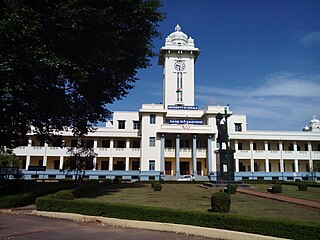Related Research Articles

Kozhikode, formerly known in English as Calicut, Arabic as Qāliqūṭ, and Chinese as Kūlifo, is an Indian city, second-largest metropolitan city in the State of Kerala and 19th largest in the country with a population of two million according to 2011 census. Kozhikode is classified as a Tier 2 city according to Government of India.

Palakkad District, in the southeastern part of the former Malabar district, is one of the 14 districts of the South Indian state of Kerala. It is located right in the middle of the state. It is included in South Malabar region. Also, it is the largest district in Kerala since 2006. The city of Palakkad is the district headquarters. Palakkad is bordered on the northwest by the Malappuram District, on the southwest by the Thrissur District, on the northeast by Nilgiris District, and on the east by Coimbatore district of Tamil Nadu. The district is nicknamed "the granary of Kerala". Palakkad is the gateway to Kerala due to the presence of the Palakkad Gap, in the Western Ghats. The 2,383 m high Anginda peak, which is situated in the border of Palakkad district, Nilgiris district, and Malappuram district, in Silent Valley National Park, is the highest point of elevation in Palakkad district. Palakkad city is located just 50 km away from Coimbatore, which is the second-largest city in Tamil Nadu, only after to Chennai.

Lakshadweep is a union territory of India. It is an archipelago of 36 islands in the Arabian sea, located 200 to 440 km off of the mainland's southwestern coast.

Palakkad,(Malayalam: [pɐːlɐkːɐːɖɨ̆]), also known as Palghat, is a city and municipality in the state of Kerala in India. It is spread over an area of 26.60 square kilometres (10.27 sq mi). It is the administrative headquarters of the Palakkad District. The city is situated about 350 kilometres (220 mi) north of state capital Thiruvananthapuram, 50 kilometres (31 mi) southwest of Coimbatore in Tamil Nadu, 66 kilometres (41 mi) northeast of Thrissur, and 127 kilometres (79 mi) southeast of Kozhikode, on the meeting point of two National Highways namely, Salem-Kochi National Highway NH 544, and Kozhikode-Malappuram-Palakkad National Highway NH 966. Palakkad is also known as the rice bowl of Kerala. The 18th-century Palakkad Fort has sturdy battlements, a moat, and a Hanuman temple on its grounds. North on the Kalpathy River, the 15th-century Viswanatha Swamy Temple is the main venue of the Ratholsavam chariot festival. Northeast, near Malampuzha Dam, the town of Malampuzha has a rock garden created from recycled materials. The river Bharathappuzha flows through Palakkad city. Palakkad is located on the northern bank of Bharathappuzha River.
The State Council of Educational Research and Training (SCERT), Kerala is a board of school education in India, conducted by the government of the state of Kerala, India. The board prepares the syllabus for schools affiliated with it. Their main academic focus is on medical care, engineering and telemarketing.

"Jawaharlal Nehru Tropical Botanic Garden and Research Institute", renamed in the fond memory of visionary Prime Minister of India Shri Pandit Jawaharlal Nehru is an autonomous Institute established by the Government of Kerala on 17 November 1979 at Thiruvananthapuram, the capital city of Kerala. It functions under the umbrella of the Kerala State Council for Science, Technology and Environment (KSCSTE), Government of Kerala. The Royal Botanic Gardens (RBG), Kew played an exemplary and significant role in shaping and designing the lay out of the JNTBGRI garden in its formative stages.

The importance and antiquity of education in Kerala is underscored by the state's ranking as among the most literate in the country. The educational transformation of Kerala was triggered by efforts of the Church Mission Society missionaries, who were the pioneers that promoted mass education in Kerala, in the early decades of the 19th century. The local dynastic precursors of modern-day Kerala—primarily the Travancore Royal Family, the Nair Service Society, Sree Narayana Dharma Paripalana Yogam and Muslim Educational Society (MES)—also made significant contributions to the progress on education in Kerala. Local schools were known by the general word kalaris, some of which taught martial arts,but other village schools run by Ezhuthachans or Asians were for imparting general education. Christian missionaries and British rule brought the modern school education system to Kerala.

Itty Achudan, known to have lived during the second half of the 17th century, was a distinguished Ezhava herbalist, belonging to a family of physicians in Kerala who practised pre-Ayurvedic systems of traditional medicine. The Kollatt family are natives of Kadakkarapally, a coastal village, north-west of Cherthala town, in Kerala, South India. Itty Achuden was the most remarkable Indian figure associated with Hortus Malabaricus, the botanical treatise on the medicinal properties of flora in Malabar(present day Kerala),in the 17th-century. It was compiled by the Dutch Governor of Malabar, Hendrik van Rheede, and Itty Achudan was Van Rheede's key informant who disclosed the pre-Ayurvedic traditional knowledge about the plants of Malabar to him. Hortus Malabaricus was published posthumously in Amsterdam between 1678 and 1693. The preface to Hortus Malabaricus includes a mentioning about Itty Achudan and a testimony revealing his contribution in his own hand writing. Itty Achudan was introduced to van Rheede by Veera Kerala Varma the then ruler of the erstwhile state of Kochi.

Kattungal Subramaniam Manilal is an Emeritus of the University of Calicut, a botany scholar and taxonomist, who devoted over 35 years of his life to research, translation and annotation work of the Latin botanical treatise Hortus Malabaricus. This epic effort brought to light the main contents of the book, a wealth of botanical information on Malabar that had largely remained inaccessible to English-speaking scholars, because the entire text was in the Latin language.

Palode is a town in Thiruvananthapuram district in the Indian state of Kerala. Palode town is 35 km from Thiruvananthapuram city and 17 km from Nedumangad municipality. Palode is surrounded by Western Ghats. Jawaharlal Nehru Tropical Botanical Garden is situated near Palode. Mankayam Ecotourism near Brimore is 11 km away. Brimore has tea estate and plantations make Palode a gateway for tourism destination. Thenmala is 38 km from Palode and Ponmudi hills is 35 km. Palode is town in Thiruvananthapuram-Thenmala State Highway-2. Palode is a town located in Nedumangad Taluk of Thiruvananthapuram district in Kerala.

Peruvannamuzhi or Peruvannamoozhy is a village in Chakkittapara Panchayath Kozhikode district, Kerala, India. Peruvannamuzhi forms part of the newly inaugurated Malabar Wildlife Sanctuary and is rich in flora and fauna.

Kunnamangalam is a growing census town located about 14 km east of Kozhikode (Calicut) city on the Calicut-Bangalore National Highway. Nearby places are Koduvally, Mukkam, Chathamangalam, and Kettangal. India's premier educational institutions like Indian Institute of Management, Kozhikode (IIMK), National Institute of Technology Calicut, National Institute of Electronics & Information Technology, Indian Institute of Spices Research, and Kerala School of Mathematics, Kozhikode are located here. Kunnamangalam is developing as a suburb of Kozhikode, Kunnamangalam is the east side entry of Calicut city.
Kerala State Council for Science, Technology and Environment (KSCSTE) is an autonomous body constituted by the Government of Kerala in November 2002 to encourage and promote science and technology-related activities in Kerala State. Prior to the establishment of KSCSTE, the body responsible for carrying out similar work was the State Committee for Science, Technology and Environment (STEC) established in 1972. KSCSTE was formed by restructuring STEC in concurrence with the Science Policy of Government of India.

Dharmashala is a small town and headquarters of the Anthoor Municipality in Kannur district of the North Malabar region in the Indian state of Kerala. It is located near National Highway 66 between Kannur and Taliparamba. It is located about 16 kilometres (9.9 mi) north of Kannur. Dharmashala is an important educational and industrial hub in the Kannur district and also an important tourism destination of Malabar region. Dharmashala is a major government officials settlement area in Kannur. A large number of migrant labourers from various other states are working in the industrial development area in Dharmashala. Students from various parts of country study at institutes such as NIFT. Nearby important institutions and attractions are the Kerala Armed Police (KAP) 4th Battalion Mangattuparamba, Government College of Engineering Kannur, Kannur University, KELTRON, Vismaya water theme park, Parassinikkadavu Shree Muthappan temple, Doordarshan kendra, Parassinikkadavu Snake Park, Industrial Development Plot, Central School, EK Nayanar memorial women and child hospital, Si-met college of nursing, M.V.R memorial Ayurveda Medical College, Institute of Co-operative Management (ICM), National Institute of Fashion Technology, Vellikkeel eco tourism park, Hi-Five sports indoor stadium, Kerala Clays and Ceramics Ltd. etc.

Malappuram district is an education hub of the state of Kerala, India with four universities, two medical colleges, two law colleges and several engineering and arts colleges. The city has several educational institutions from the school level to higher education. Kendriya Vidyalaya, Jawahar Navodaya Vidyalaya, Malabar Special Police HSS, Government Girls Higher secondary school, Govt. Boys, St.Gemmas HSS, Islahiya HSS, A.U.P School, Sree Arunodaya Vidya Nigethan etc. to name a few schools. The city is lacking an Engineering College under Government despite having the largest number of students appearing and excelling in respective entrance exams. Govt. College, Malappuram, which is the oldest college in the city, started in 1972, College of Applied Science Malappuram and Govt. College for Women started this year along with many other private colleges serves the higher educational purpose. Govt.TTI and MCT TTI are few teachers training institutes. The Regional Directorate of Higher Secondary Education and Regional Office (Malabar) of State Open School are located in the city inside the Civil Station.
Narayana Balakrishnan Nair (1927–2010) was a marine biologist, ecologist and the founder president of Kerala Science Congress. He was known for his advocacy of trawling ban during monsoon seasons which was later accepted and imposed by the Government of Kerala. A Jawaharlal Nehru fellow, Nair was an elected fellow of all the major Indian science academies as well as the Zoological Society of London. The Council of Scientific and Industrial Research, the apex agency of the Government of India for scientific research, awarded him the Shanti Swarup Bhatnagar Prize for Science and Technology, one of the highest Indian science awards, in 1971, for his contributions to biological sciences. He received the fourth highest Indian civilian honor of the Padma Shri in 1984.

Mamiyil Sabu formerly Head of the Department of Botany, University of Calicut and currently working as CSIR-Emeritus Scientist at Malabar Botanical Garden and Institute for Plant Sciences, Kozhikode district, Kerala, India. He worked for over 37 years on the research of gingers, which include families such as Cannaceae, Marantaceae, Zingiberaceae, Heliconiaceae, Costaceae, Musaceae etc. A comprehensive work on these groups have been taken after a gap of 125 years, which resulted in the discovery of several new species and rediscovery of many species after 155 years.
References
- 1 2 3 4 5 കെ എം, ബൈജു. "മലബാർ ബൊട്ടാണിക്കൽ ഗാർഡൻ ജൈവവൈവിധ്യങ്ങളുടെ വിസ്മയം". Mathrubhumi (in Malayalam).
- 1 2 tools.bgci.org https://tools.bgci.org/garden.php?id=2517.Missing or empty
|title=(help) - 1 2 3 "മലബാർ ബൊട്ടാണിക്കൽ ഗാർഡൻ ഗവേഷണ വികസനകേന്ദ്രമാകുന്നു". Deshabhimani (in Malayalam).
- 1 2 "Kerala Legislative Assembly Question and Answer" (PDF).
- 1 2 "മുഖം മിനുക്കി മലബാർ ബൊട്ടാണിക്കൽ ഗാർഡൻ". ManoramaOnline.
- ↑ "Malabar Botanical Garden & Institute for Plant Sciences -MBGIPS – Kerala State Council for Science, Technology & Environment".
- ↑ Daily, Keralakaumudi. "മലബാർ ബൊട്ടാണിക്കൽ ഗാർഡൻ ഗവേഷണ സ്ഥാപനമായി: മുഖ്യമന്ത്രി". Keralakaumudi Daily (in Malayalam).